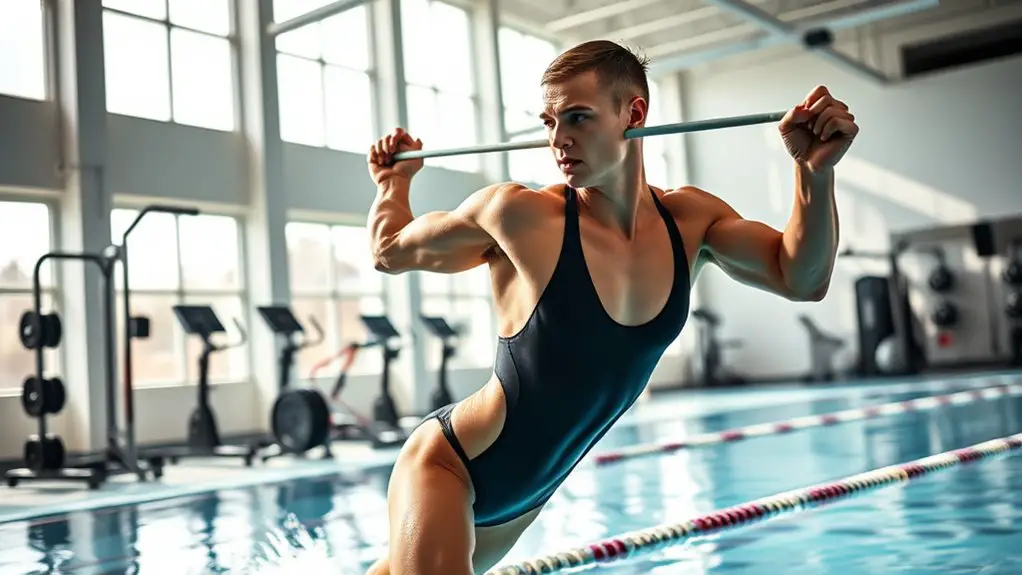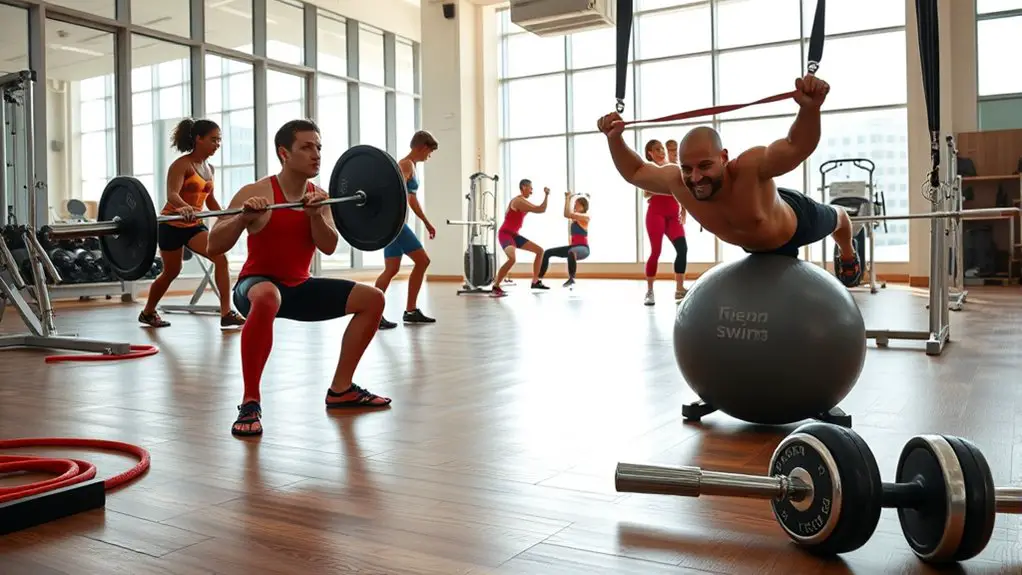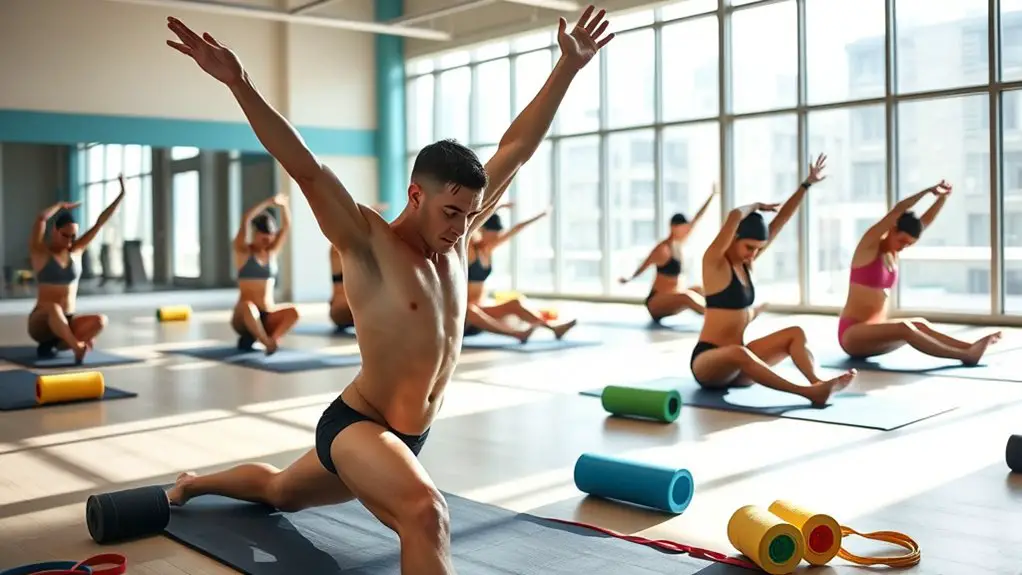The Best Gym Workouts for Swimmers

The best gym workouts for swimmers combine strength training, core stability, flexibility, and cardio endurance. Focus on compound movements like squats and deadlifts to engage multiple muscle groups. Don’t forget core exercises like planks and rotational movements for efficiency in the water. Incorporate dynamic stretches and foam rolling for improved flexibility and mobility. Additionally, high-intensity interval training can boost your cardiovascular stamina. There’s much more to explore about how these elements improve your swim performance.
Strength Training Essentials for Swimmers

When you’re looking to enhance your swimming performance, incorporating strength training is essential. It not only builds muscle but also supports swimming biomechanics, improving your efficiency in the water. Focus on compound movements, like squats and deadlifts, which engage multiple muscle groups and mimic the actions used in swimming.
Make sure to use proper form to prevent injuries—start with lighter weights and gradually increase as you gain strength adaptations. Target your upper body, core, and legs to create a balanced workout that supports your swim technique. Exercises like pull-ups and bench presses can strengthen your shoulders and chest, vital for powerful strokes.
Don’t forget to include flexibility training as part of your routine. Stretching can enhance your range of motion, allowing you to swim more effectively. With consistent strength training, you’ll notice significant improvements in your overall swimming ability and performance.
Core Stability: The Foundation of Swimming Power
Core stability is vital for swimmers, as it directly influences your power and efficiency in the water. By enhancing core engagement, you create a solid foundation that improves your technique and reduces the risk of injury. Incorporating stability drills into your workout can greatly benefit your swimming performance.
Here are three effective stability drills to include:
- Planks: Hold a stable plank position to strengthen your entire core. Focus on maintaining proper form to maximize engagement.
- Russian Twists: This drill enhances rotational strength, essential for strokes like freestyle and backstroke. Just be sure to keep your movements controlled.
- Bicycle Crunches: These help develop both your abdominal and oblique muscles, supporting better balance in the water.
Flexibility and Mobility Exercises for Swimmers

To enhance your swimming performance, incorporating flexibility and mobility exercises is key. Dynamic stretching techniques can help improve your range of motion, while foam rolling can relieve muscle tightness and enhance recovery. Let’s explore how these practices can benefit your swim training.
Dynamic Stretching Techniques
Dynamic stretching techniques are essential for swimmers looking to enhance their flexibility and mobility. Incorporating these dynamic warm-ups into your routine can help prevent injuries and improve performance. Remember to focus on controlled movements while performing mobility drills. Here are three effective dynamic stretching techniques:
- Leg Swings: Stand next to a wall for support and swing one leg forward and backward to loosen up your hips.
- Arm Circles: Extend your arms out to the sides and make small circles, gradually increasing the size to warm up your shoulders.
- Walking Lunges: Step forward into a lunge, alternating legs, to engage your lower body and stretch your hip flexors.
Integrate these exercises into your routine, and you’ll feel more agile in the water!
Foam Rolling Benefits
After incorporating dynamic stretching techniques, adding foam rolling to your routine can further improve flexibility and mobility. Foam rolling techniques help release tension in your muscles, enhancing blood flow and promoting muscle recovery. By targeting specific areas, you can alleviate tightness, which is essential for maintaining ideal performance in the water.
When you roll out knots and trigger points, you’re not just easing discomfort; you’re also enhancing your range of motion. To guarantee safety, focus on rolling slowly and avoid overdoing it on sensitive areas. Integrating foam rolling into your post-workout routine can greatly benefit your overall flexibility, allowing for smoother strokes and better endurance during swims. Prioritizing this practice can lead to a more effective training regimen.
Cardiovascular Conditioning for Endurance
While many swimmers focus on pool workouts for endurance, incorporating cardiovascular conditioning in the gym is just as crucial. Enhancing your aerobic capacity through gym workouts can greatly boost your swimming performance. Here are three effective ways to achieve this safely:
Incorporating gym-based cardiovascular workouts is essential for enhancing swimming performance and aerobic capacity.
- Interval Training: Alternate between high-intensity bursts and moderate activity. This method improves both endurance and speed while reducing injury risk.
- Cycling: Whether on a stationary bike or outdoors, cycling builds stamina without the joint stress that running might impose.
- Rowing: This full-body workout elevates your heart rate and strengthens your core, which is essential for maintaining proper swimming form.
Additionally, consider integrating skipping rope into your routine as it provides an effective cardio workout that can enhance endurance and burn calories. Always listen to your body and gradually increase intensity to avoid overexertion. By integrating these gym-based cardiovascular workouts, you’ll enhance your endurance and overall performance in the pool.
Plyometric Workouts to Boost Explosiveness

Plyometric workouts can greatly enhance your explosiveness in the water, making them essential for swimmers. These high-energy exercises focus on quick, powerful movements that build strength and speed. One effective plyometric move is box jumps. Start with a sturdy box at a height you’re comfortable with, and jump onto it, landing softly to absorb the impact. Aim for three sets of 8-10 reps, ensuring you maintain proper form to avoid injury.
Another great option is explosive push-ups. Position yourself in a standard push-up stance, and as you push up, explode off the ground, clapping your hands if you can. Perform three sets of 5-8 reps, focusing on controlled landings. Always warm up beforehand and listen to your body to prevent strain. Incorporating these exercises into your routine can profoundly boost your performance in the pool, helping you achieve your swimming goals safely.
Resistance Training Techniques for Improved Stroke Mechanics
Building explosiveness in the water is just one part of enhancing your swimming performance. Incorporating resistance training techniques can greatly improve your stroke mechanics. Here are three effective methods to take into account:
- Resistance Bands: Use these to simulate swimming motions. Anchor them securely and practice your stroke drills, focusing on form while feeling the added resistance.
- Weighted Pull-Ups: This exercise strengthens your back and shoulders, essential for powerful strokes. Start with your body weight, then gradually add weight as you get stronger.
- Medicine Ball Throws: Perform rotational throws to engage your core and improve your overall body mechanics. This mimics the twisting motion in swimming, enhancing your propulsion.
Always warm up before starting your workouts and pay attention to your body. Incorporating these resistance training techniques can help you swim faster and more efficiently while maintaining safety.
Recovery and Injury Prevention Strategies for Swimmers
To maximize your swimming performance and stay injury-free, it is essential to prioritize recovery and injury prevention strategies. Incorporating active recovery into your routine can considerably enhance muscle repair and overall performance. Light activities like walking, yoga, or swimming at an easy pace help maintain blood flow to your muscles without overexerting them.
Injury management is equally important; pay attention to any signs of discomfort and address them early. Regularly stretching and strengthening key muscle groups can reduce the risk of injuries commonly associated with swimming. Additionally, consider integrating foam rolling and mobility exercises, which can enhance flexibility and alleviate tension.
Don’t forget to hydrate and refuel your body with nutritious foods after workouts. By making recovery a priority and implementing these strategies, you’ll not only improve your swimming but also guarantee a long-lasting and injury-free journey in the pool.
Frequently Asked Questions
How Often Should Swimmers Incorporate Gym Workouts Into Their Training?
You should aim to incorporate gym workouts into your training at least 2 to 3 times a week. This frequency allows you to build strength without risking injury. It’s important to establish a gym schedule that complements your swim practices, ensuring you don’t overtrain. Listen to your body and adjust your training frequency if you feel fatigued. Balancing strength training and swimming will enhance your performance while keeping you safe and healthy.
What Are the Best Gym Machines for Swimmers?
When you’re looking for the best gym machines, think of them as your trusty sidekicks. Resistance training is key, so machines like the leg press and lat pulldown are great choices. Don’t forget about core stability—plank machines or stability balls can really help. Always prioritize safety; make certain you’re using the correct form and adjusting weights appropriately. With the right machines, you’ll strengthen your muscles and improve your overall performance!
Can Swimming Alone Provide Enough Strength Training?
While swimming offers fantastic cardiovascular benefits and builds endurance, it might not provide enough strength training on its own. You’ll develop muscle tone, but to truly enhance strength, incorporating resistance training is crucial. It’s important to balance your workouts to prevent injuries and guarantee a well-rounded fitness routine. By adding strength exercises, you’ll complement your swimming benefits and help improve your overall performance in the water safely.
What Should Swimmers Eat Before Gym Workouts?
Before hitting the gym, you’ve got to contemplate your pre workout nutrition. It’s a balancing act—fueling up without feeling weighed down. Aim for a light meal about 30–60 minutes prior, focusing on easily digestible carbs and protein. Think a banana with some peanut butter or a yogurt. Proper meal timing can enhance your performance while keeping you safe from stomach discomfort. Remember, it’s all about finding what works best for you!
How Can Swimmers Track Their Gym Workout Progress Effectively?
To track your gym workout progress effectively, consider using workout journals. They help you log exercises, sets, and reps, making it easier to see improvements over time. You can also note how you feel during workouts to guarantee you’re prioritizing safety and avoiding injury. Regularly reviewing your journal will keep you motivated and focused on your goals. Remember, consistency is key to tracking progress and achieving the results you desire.





